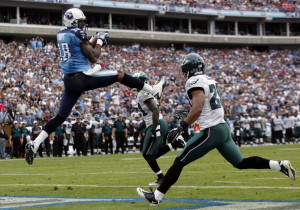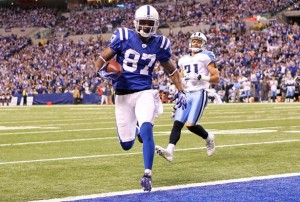During the 2013 offseason, I wrote 32 articles under the RPO 2013 tag. In my Predictions in Review series, I review those preview articles with the benefit of hindsight. Previously, I reviewed the AFC West and the NFC West. Today, the AFC South, beginning with a straightforward case in Tennessee.
Can Kenny Britt become the next great wide receiver?, July 9, 2013Spoiler alert: Kenny Britt did not become the next great wide receiver, at least in 2013 (apparently, I still can’t quit him). Britt is an easy player to fall in love with, if you ignored the warning signs. He was just 20 years old when he played in his first NFL game in 2009. In 2010, he led all players in yards per route run according to Pro Football Focus, but his raw numbers underhwlemed because the Titans were a run-heavy team and Britt missed 30% of the season with a hamstring injury. In 2011, he matched his elite YPRR production, but a torn ACL/MCL tear ended his season after 94 pass routes.
He struggled in 2012, but I was willing to write that off due to recovering from the ugly knee injury, additional hamstring and ankle injuries, and a first-year starter in Jake Locker. That set up 2013 as a season where I thought Britt had great breakout potential. I interviewed Thomas Gower, of Total Titans and Football Outsiders, and asked him his thoughts. Gower was more pessimistic than I was about Britt, and for good reason.
As it turned out, Britt never seemed quite right mentally (in more ways than one); he struggled with drops and was eventually dropped behind Justin Hunter and Kendall Wright on the depth chart. He finished the year with 11 catches for only 96 yards and no touchdowns. In late December, Britt said he would definitely be a #1 wide receiver somewhere in 2014, which means I’m susceptible to falling into the Britt trap again.
What can we learn: This is a tricky one. The obvious takeaway is not to overlook effort, mental, and off-the-field issues. Britt had the character label affixed to him no matter what definition you used. Of course, writing off all players with character issues isn’t the answer, but in retrospect, the telltale sign was the team’s decision to spend top-35 picks on Wright and Hunter in back-to-back years.
Will Gus Bradley help fix the Jaguars defense?, July 16, 2013
In 2013, the Jaguars were the only team to go the defensive coordinator route when finding a new head coach, selecting former Seahawks coordinator Gus Bradley. As we now know, the Seattle defense didn’t miss Bradley too much, but the main question I had was what Bradley would do to the Jaguars defense.
What I discovered was that, in general, defensive coordinators were more successful at immediate turnarounds of their new team’s defense than offensive coordinator hires were at turning around their new team’s offense. On average, the teams that hired defensive coordinators as new head coaches jumped from 23rd in points allowed, 19.5 in yards allowed, and 24.5 in Expected Points Allowed to 13.5, 18, and 22, respectively. While regression to the mean aids these turnarounds, it’s worth noting that such regression didn’t take place for the OC hires.
As it turned out, Jacksonville finished the season 28th in points allowed, 27th in yards allowed, and 26th in NY/A allowed. Advanced NFL Stats had the Jaguars 30th in EPA, while Football Outsiders had the 28th. Those numbers are all similar enough to the team’s 2012 output, so Bradley didn’t do much to improve the team’s defense. Of course, it’s far from clear how much blame he really deserves, either.
What can we learn: The Jaguars entered the 2013 offseason with massive talent deficiencies on both sides of the ball, but the lack of star players was particularly glaring on defense. Bradley couldn’t turn water into wine, although I’ll note that Rob Ryan arguably did just that in New Orleans; of course, Ryan has had more than his share of years with talent-deficient defenses where his teams languished at the bottom of the defensive rankings. After taking OT Luke Joeckel in the first round, the Jaguars hit the secondary at the top of the second and third rounds, drafting S Jonathan Cyprien and CB Dwayne Gratz. Neither player was able to fix the team’s secondary issue, although Cyprien led all Jaguars defenders in snaps. But without a rookie superstar and no major free agent impact players (Alan Ball, who had the most starters of any Jaguar cornerback, may have been the best of the haul), this defense never had much of a chance of success in 2013.
As for the broader point, one example doesn’t mean much, so in general, we might expect defensive coordinators to have some initial success, at least on defense. For 2014, that might mean good things for Mike Pettine in Cleveland, Mike Zimmer in Minnesota, and, while not technically meeting the definition, Lovie Smith in Tampa Bay.
The 2012 Colts were very rookie-heavy, with one big exception, July 22, 2013After slashing the team in the post-Peyton Manning era, the Colts entered 2012 with low expectations and a lot of rookies. As it turned out, 26% of the Approximate Value produced by the Colts in 2012 came from rookies, an abnormally high rate and only the 2nd team since 1990 to hit such a high threshold (the 2012 Browns were the other). The one outlier on the offense, however, was the second most important piece: wide receiver Reggie Wayne.
As we now know, Wayne wound up tearing his ACL in an October victory against the Broncos. Fortunately for Indianapolis and Andrew Luck, Wayne’s absence allowed T.Y. Hilton to develop into a number one wide receiver. But Luck’s efficiency numbers didn’t rise as one would have hoped: while he significantly cut his interception rate, Luck actually averaged fewer NY/A in 2013 than he did in 2012, although part of that was due to the offense’s more conservative nature (his completion percentage rose from 54.1% to 60.2%)
What can we learn: The Colts should have been better prepared for a Wayne injury: it’s never surprising when a 35-year-old receiver gets hurt. The Darrius Heyward-Bey acquisition was a bust, and it was a rough year for Ryan Grigson. The Colts one-dimensional offense centered around Hilton was slowed down in the loss to the Patriots, although losing Dwayne Allen for the year in September hurt, too. The window is wide-open for Indianapolis due to the age of the offense, but the Colts need to provide Luck with more weapons: expecting Wayne, who turns 36 in November, to bounce back to his former level would be unwise.
Examining Games with More than 15 Carries, August 12, 2013
To measure running back workload, I tracked the number of carries a running back recorded after his 15th carry of the game. In 2012, Arian Foster ranked #1 in this metric with 117 carries over 15 carries. Did this mean Foster was more likely to get injured in 2013? As I discovered, the answer was no: workhorse backs weren’t more likely to get hurt the following year. Foster then proceeded to ruin my article by getting hurt; he finished 2013 with just 542 rushing yards over eight games.
What What can we learn: Foster may have finally succumbed to years of heavy workloads, and one could make the same argument about 2013 Ray Rice. The problem is the data doesn’t suggest that players with high workloads are more likely to miss games. If Alfred Morris and Marshawn Lynch are injured next year, we’ll say that high workloads lead to injuries. If they stay healthy, the narrative will simply be that they’re good at avoiding injuries. Up until 2013, so was Foster. As always, seeing the writing on the wall due to overuse is much clearer with the benefit of hindsight.


